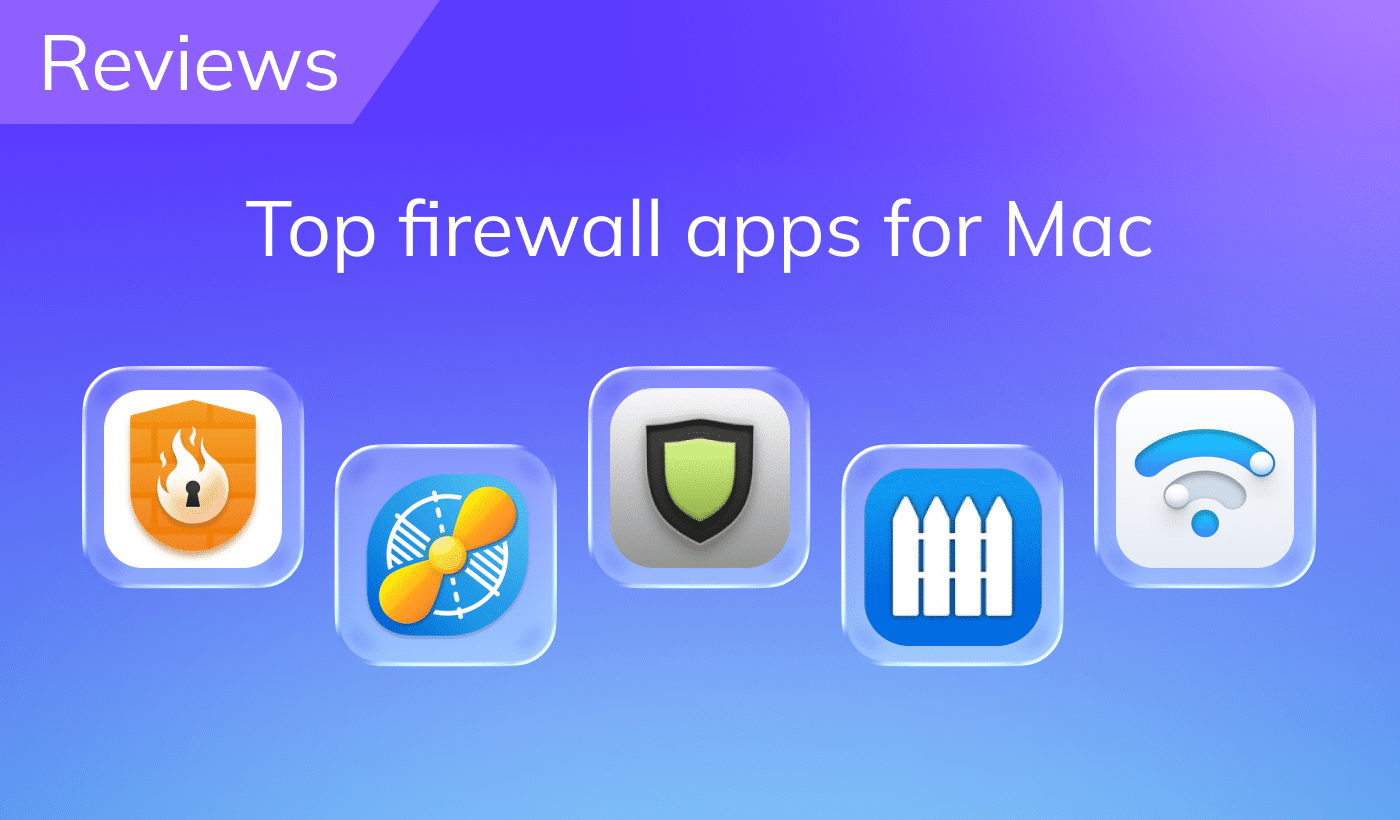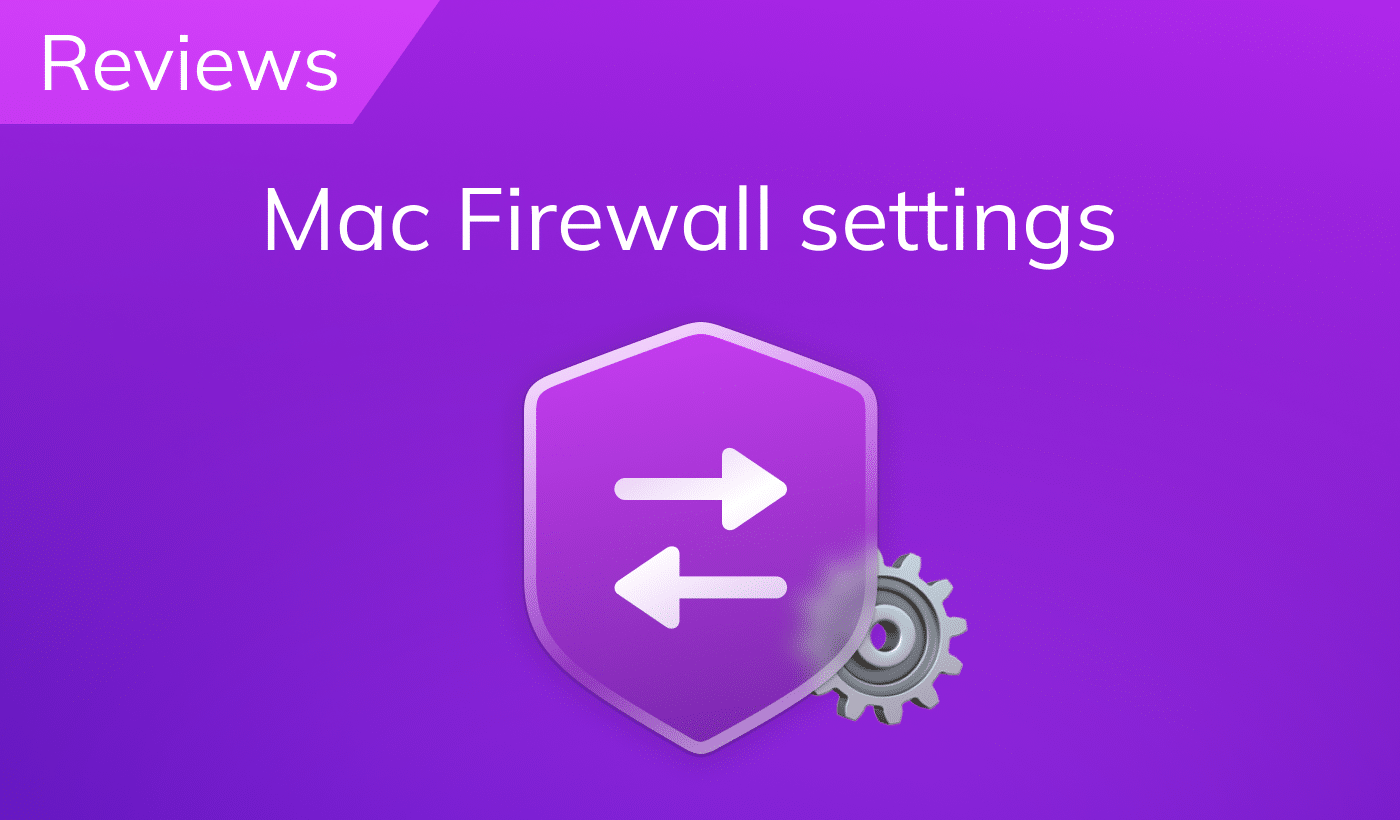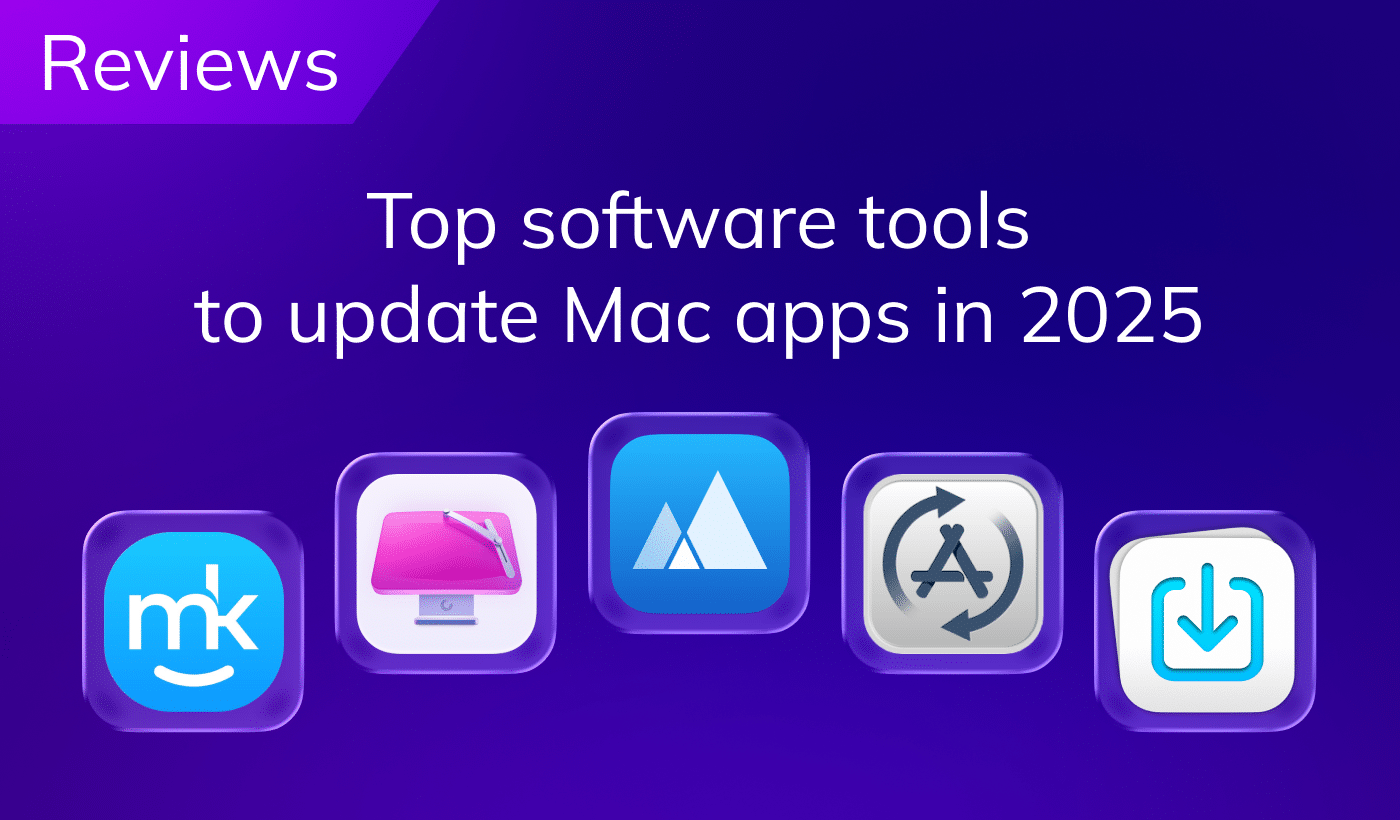October 17, 2025
What is a firewall on a Mac? A complete beginner’s guide
Let’s face it: every 2 seconds, ransomware hits a business, a person, a device – no one’s safe. The price tag? $10.5 trillion globally. It’s why you and I need to treat security on our Macs as seriously as we treat locking our front door. And the firewall locks that door.
You’ve definitely heard the word firewall a hundred times, but never got to the bottom. Now’s your shot to figure out what a firewall really does.
This blog post will tell you what a firewall is, about its types, how it works, why it’s important for your Mac, how a firewall protects private and corporate networks, whether it is worth enabling it, and its differences with antivirus and VPN.
What is a Firewall?
A firewall is a security system that watches over the traffic coming in and out of your device.
Its main purpose is to create a barrier between a trusted network (like your computer or private company network) and untrusted networks (like the internet).
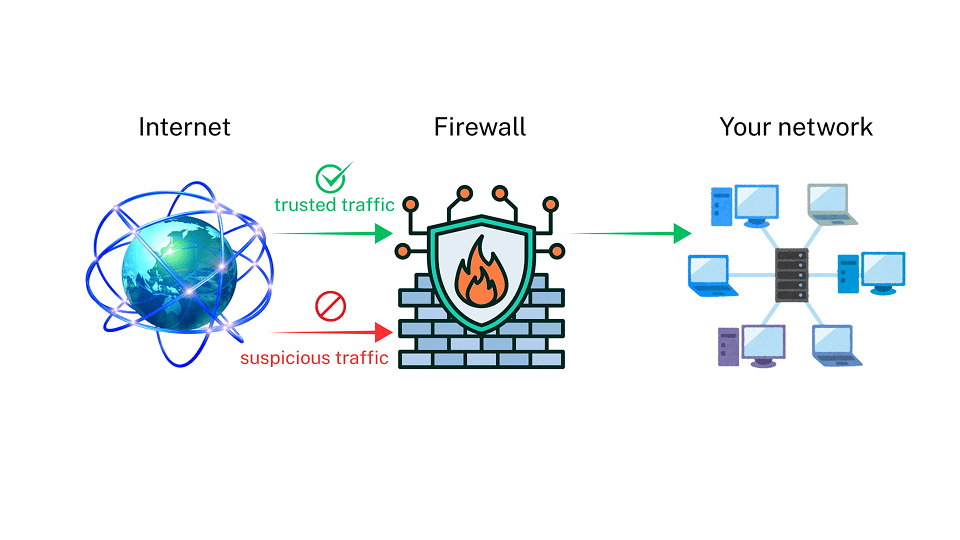
How it works
Every time your device talks to the internet, it sends and receives data packets. A firewall sits in between and inspects those packets. It looks at the traffic, checks against its rules, and then makes a call: allow or block. It’s like a bouncer at a club. Known, safe traffic? Welcome inside. Unknown, shady connections? Blocked at the door.
The rules it follows can be preset or ones you tweak yourself. For example:
- Permit traffic only through secure protocols (like HTTPS).
- Block traffic from IP addresses flagged as dangerous.
- Stop peer-to-peer apps like BitTorrent from connecting.
- Keep logs of suspicious behavior, such as repeated failed login attempts.
- Stop unknown apps from sending data out without your say.
A firewall can work in two ways:
- Inbound filtering. Stops unwanted connections from reaching your machine.
- Outbound filtering. Prevents sketchy apps from secretly sending data out.
Types of firewalls
Now, here’s where it gets a little more fun: firewalls aren’t one-size-fits-all. There are a few main types, and each works a bit differently:
| Type | Description |
|---|---|
| Packet-filtering firewall | The most basic type. It checks each packet’s source/destination IP, port, and protocol, then decides whether to allow or block. Fast, but not very smart. |
| Circuit-level gateway | Works at the session level. It monitors TCP handshakes (connections) to ensure they’re legitimate. Simple and efficient, but it doesn’t inspect packet contents. |
| Stateful inspection firewall | Smarter than packet filtering. Tracks the state of active connections, making sure packets are part of a valid session. More secure, widely used. |
| Proxy firewall (application-level gateway) | Acts as an intermediary between your device and the internet. It hides your real IP, filters traffic at the application layer, and can block malicious content. Slower, but very secure. |
| Next-generation firewall (NGFW) | The most advanced type. Combines traditional firewall features with intrusion prevention, deep packet inspection, malware detection, and even app/user-based filtering. Ideal for modern threats. |
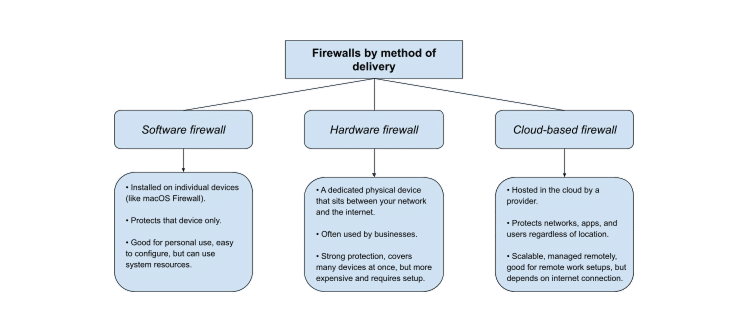
How the macOS built-in firewall works
Apple ships macOS with a built-in firewall. It’s software-based and designed to block unwanted incoming connections. By default, it’s off (yep, really). You need to turn it on manually if you want the extra protection. I’ll show you how to do it below.
It’s lightweight, reliable, and works quietly in the background. But like most things built-in, it’s pretty minimal. It won’t block outgoing traffic, and it doesn’t give you deep reports on what’s happening.
When enabled, the macOS firewall filters inbound connections. That means:
- Apps you don’t trust won’t be able to accept incoming connections.
- Hackers scanning random IP addresses for open doors won’t get through.
- You get to decide which apps are allowed to receive network requests.
It doesn’t slow down your Mac, and you probably won’t notice it doing its thing – until it saves you from an unwanted intrusion.
macOS and third-party firewalls
- macOS firewall. Free, built-in, and super easy to switch on. Great for blocking incoming connections, but that’s about it.
- Third-party firewalls. Give you more control. They can monitor both incoming and outgoing traffic, alert you in real time, and log everything for review. Some even include intrusion detection or app-level monitoring.
In short, Apple’s firewall is fine for casual use. If you want pro-level control, you’ll need third-party software.
Should you enable the Firewall on Mac?
If you’re wondering whether the firewall on your Mac is worth turning on, the short answer is: yes, in most cases. It adds an extra security layer between the Mac and the outside world. While it’s good practice to leave it on all the time, these are the times it matters most:
- When connected to public Wi-Fi
Airports, coffee shops, and hotels – strangers share the same network, making your Mac more vulnerable. A firewall blocks random connection attempts. - When working remotely
If you log into company systems from outside the office, a firewall adds another security layer between your device and the internet. - When running services that could expose your Mac
Example: file sharing, remote desktop, or web servers. A firewall lets you limit which apps or devices can connect. - When handling sensitive data
If you store financial info, client files, or work documents, a firewall reduces the risk of unauthorized access. - When you want to stay less visible
Enabling stealth mode on the macOS firewall makes your Mac ignore ping requests, so attackers can’t easily detect you.
But like any tool, it has strengths and weak spots.
Pros. Built-in firewall on a Mac can protect you from:
- Unauthorized incoming connections: Blocks unknown apps or services from trying to connect to your Mac without permission.
- Hackers scanning your Mac: Stops random probes from the internet looking for open doors (ports) to break into.
- Malicious apps listening for connections: Prevents shady software installed on your Mac from accepting outside requests.
- Remote attacks: Reduces the risk of someone gaining control of your Mac over the network.
- Unwanted sharing services: Lets you turn off or limit access to things like file sharing, screen sharing, and remote login.
- Stealth mode: Hides your Mac from being visible on a network so it won’t respond to pings or discovery attempts.
Cons. Where Mac Firewall falls short:
- Inbound only: It doesn’t block outgoing connections, so if a sneaky app is already on your Mac, the firewall won’t stop it from sending data out.
- Pop-ups can feel naggy: You may get alerts asking to allow or deny connections, especially when installing lots of apps.
- No help once malware is inside: A firewall won’t stop you from downloading a malicious file or clicking a bad link. It doesn’t kick infections out if it’s on a Mac.
- Tiny performance hit: It adds a small bit of processing. You won’t notice on a modern Mac, but in heavy-duty setups, it can slow down traffic.
- False sense of security: Turning on the firewall doesn’t mean you’re 100% safe. You still need antivirus, VPN, and good browsing habits.
So yeah, firewalls are fantastic, but they’re not a silver bullet. It’s like one lock on the door. You wouldn’t rely only on a lock without also shutting the windows, right?
But what if you don’t lock that door at all? Leaving the firewall off means you’re more exposed to scans, probes, and unauthorized access attempts that could have been stopped. Here’s a side-by-side view of what you win/lose with firewall on/off:
| Feature/situation | Firewall ON ✅ | Firewall OFF ❌ |
|---|---|---|
| Unauthorized incoming connections | Blocked automatically | Wide open, apps/services can connect without permission |
| Hackers scanning Mac | Hidden from most probes | Your Mac may respond and reveal open ports |
| Shady apps listening for outside requests | Blocked by default | Allowed unless you catch them yourself |
| Remote attacks | Greatly reduced risk | Higher risk of unauthorized remote control |
| Sharing services (file, screen, remote login) | You choose what’s allowed | All enabled services stay exposed |
| Stealth mode | Mac invisible on the network | Mac responds to pings, visible to attackers |
| User experience | Occasional prompts to allow/deny connections | No prompts, but less protection |
So, with the firewall on, you stay under the radar and block the most common intrusions. With it off, you’re trusting the internet to play nice. And that’s a risky bet.
How to check if the firewall is enabled on Mac
- Open System Settings.
- Go to Network in the left sidebar.
- Select Firewall.
- If it says the firewall is currently turned off, toggle it on.
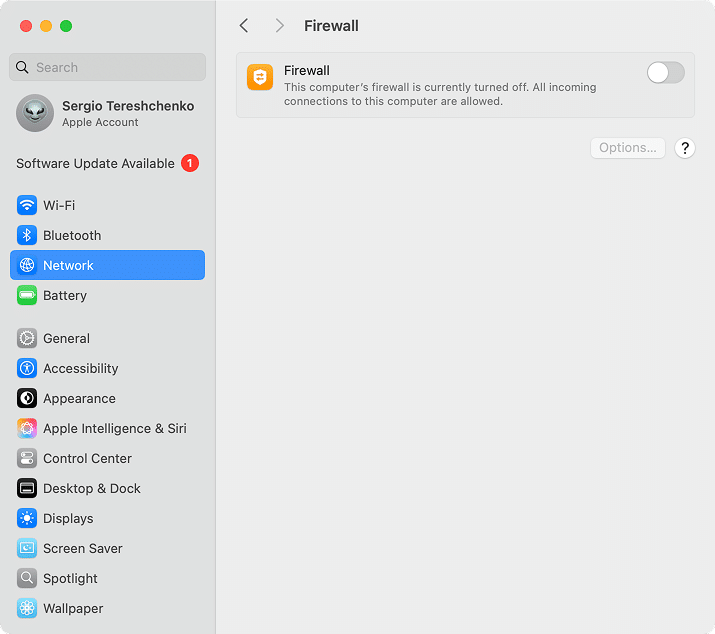
Mac Firewall advanced settings
Once you’ve switched the firewall on, you can take it a step further with a few advanced options Apple hides under the hood. Here’s how you find them:
Block all incoming connections
- Once you enable Firewall, you can click Options.
- At the top, locate and check Block all incoming connections.
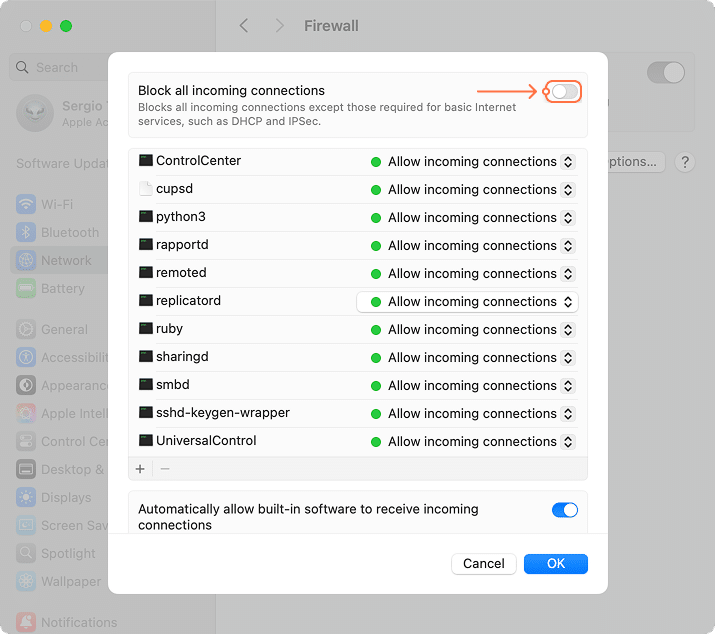
This is the nuclear option. Nothing gets through except basic services required for macOS.
Add app rules manually
- Being in the Firewall Options tab, locate and click + button under the app list.
- Choose the app you want to allow or block.
- Locate the application on the list → control-click it.
- Select Block incoming connections.
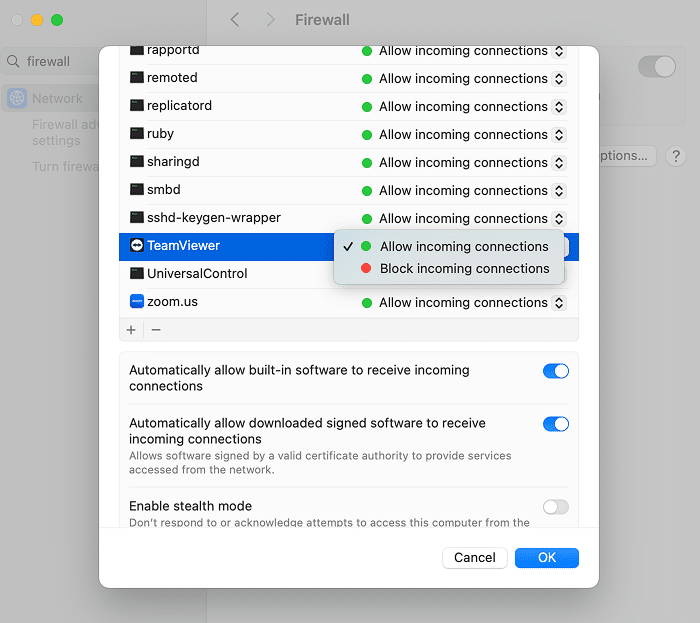
You get to say which apps are allowed to accept connections and which aren’t. For example, you might allow Zoom but block a sketchy tool you only use offline.
Turn on Stealth Mode
- In the Firewall Options tab, scroll down to the tab bottom.
- Locate Enable stealth mode and toggle it on.
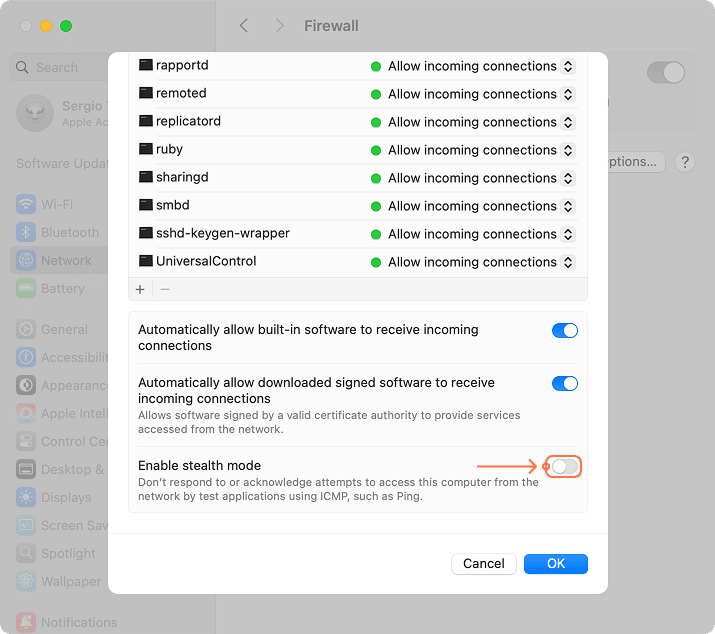
When it’s enabled, your Mac won’t respond to network pings or discovery attempts, which makes you more invisible. Hackers running scans won’t even know you’re there.
Firewall vs. Antivirus and VPN on Mac
Here is a quick reminder: a firewall isn’t the same as an antivirus or a VPN. They’re three very different tools, each with its own job:
- A firewall controls traffic
- Antivirus detects and removes malware
- A VPN hides your identity and encrypts your connection
Together, they’re like locks, alarms, and blinds for your digital home; each protects you in a different way.
| Tool | Main purpose | Protects you from | Doesn’t protect you from |
|---|---|---|---|
| Firewall | Blocks or allows network traffic based on rules. | Unauthorized connections, port scans, remote attacks. | Viruses already on your Mac, phishing, malicious downloads. |
| Antivirus | Detects, quarantines, and removes malware. | Viruses, trojans, ransomware, infected files. | Hackers scanning your network, unauthorized connections. |
| VPN | Encrypts your internet traffic and hides your IP address. | ISP tracking, geo-restrictions, unsafe public Wi-Fi spying. | Malware infections, unauthorized incoming connections. |
How it works together with antivirus/VPN
So, the real strength comes when you use all three. The firewall blocks unwanted traffic, the antivirus scans and removes anything that sneaks in, and the VPN keeps your data private. Together, they give you a multi-layered defense: a firewall at the door, antivirus inside the house, and VPN covering your tracks outside.
Final verdict
In our reality, where cyberattacks are relentless and Macs are no exception, turning on Mac’s firewall is the simplest and most effective way to boost security. It shields you from:
- unwanted traffic
- unauthorized access
- malicious scans
- remote attacks that could otherwise slip past unnoticed
Firewall gives you that essential first line of defense every Mac should have.
And your Mac deserves a secure solution you can rely on. Don’t stop at the basics. Bastiont adds advanced protection and app-level monitoring, so your Mac isn’t just safe, it’s fortified. Figure out how to prepare your Mac for tomorrow’s risks with Nektony today.
